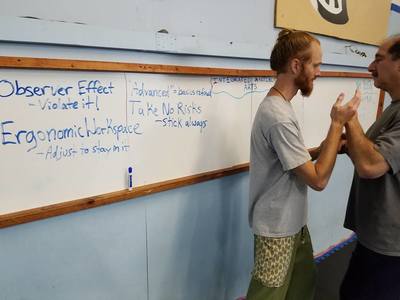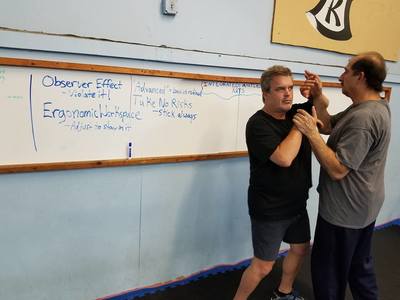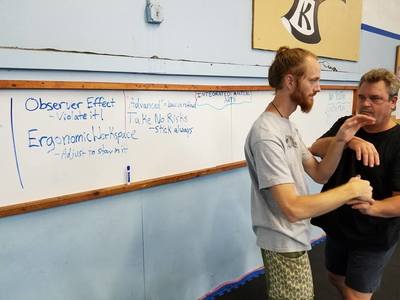I’ve heard in other endeavors (for example, target shooting) that there is no such thing as “advanced”. “Advanced” is merely the basics refined, or more deeply understood. I think that can apply to Guided Chaos as well.
For example:
I told my students that I would like them to be able to, as a failsafe/backup plan at the very least, use their hands to constantly stick with their training partner’s hands, no matter what happens. Logically, if you can unfailingly stick with the hands, the only way you could be hit is if you’re basically forced to hit yourself! Most of us go through life without hitting ourselves (much) because we are naturally deeply aware of the position of our own hands moment by moment. If your hands are stuck to the hands of another person, that person’s hands become our own in terms of awareness.
One key point is that you want to be able to stick completely passively, not affecting the other person at all. To affect the other person is to create resistance somewhere, which could entail inappropriate tension and make your balance vulnerable. There is a phenomenon in science called the “observer effect.” The concept is that it’s impossible to observe something without in some way affecting or changing the thing being observed. This is scientifically true (as far as I know), but I want my students to achieve such passivity in their sticking that they VIOLATE the observer effect—in other words, they stick to the training partner so passively in order to be aware of and observe his/her motion that there is no effect on the training partner. It’s a lofty goal but creates a good mindset for this training.
The pursuit of constant, passive sticking changes the student’s mindset from one of fear and combativeness to one of serene neutrality much more conducive to good subconscious learning in this context. No longer is the student moving to “not be hit” or to “hit” the training partner. The student must simply move his/her body in a way that allows continued comfortable observation of the training partner’s movement via sticking.
We do our best work with our hands when our hands are within our natural ergonomic workspace. If you wanted to prepare food, assemble a small device, or examine the form and texture of a small object, you would naturally (whenever possible) do all this within the space in front of you, roughly between your eyes and belly button, between your shoulders, and from a hand’s width in front of your sternum to the distance of your nearly outstretched (but not fully extended) arms. This is the space where you are naturally most comfortable and dexterous, and best able to maximally relax while taking in maximum information. In everyday life, the rest of your body naturally adjusts to accommodate the situation and put your workspace where it needs to be for the task at hand. In contact flow, we can do the same thing: move the whole body (body unity) to keep our sticking hands within our ergonomic workspace to the greatest degree possible, so that we can passively stick and feel with maximum comfort and relaxation. Notice the effect here: If we are moving our body to accommodate our sticking hands and keep them within our workspace, that means we are automatically moving our body to accommodate our training partner’s body and remain “safe” from it.
Here’s another idea: Even if the contact point changes from our hand to another part of our body, that body part should act like a hand and continue to passively stick without creating an effect. So that means that if our training partner’s hand, elbow, etc. happens to touch our torso, for example, the point where the contact is should act as an additional hand to simply stick to the training partner with no resistance. Our body accommodates to allow this to happen smoothly until our actual hand can get back to doing what it does best (sticking, in this case). Note the difference in mindset and effect: I am not yielding, pocketing, turning or sinking my body to “absorb” or “avoid getting hit,” but instead I’m merely continuing to stick with and learn from my partner’s body, using my arm, shoulder, chest, abdomen, back, even neck or head as a passive sticking tool. (Hips and legs too by the way!)
So! If we can constantly stick passively with our training partner’s body, our own body constantly adjusting and accommodating to remain maximally relaxed and balanced, keeping the action as much as possible within our natural workspace and minimizing any effect we may have on our training partner, what could go wrong? How could we ever get “hit” with force?
But then again . . . how could we “hit” our training partner?
Tim explained that early in his training, he learned to play “all defense,” sticking well in order to avoid getting hit. This was especially important when he worked with the people in class who were bigger, stronger, faster and tougher than he was. He learned that he could not go “out of his way” in an attempt to hit his training partner, because the resulting loss of sticking would make him vulnerable, either during his own strike on immediately after. Instead, he learned the “math” of hitting with minimal risk to himself. In the process of sticking and moving his body to accommodate, if his training partner were to bring his hand (that Tim is sticking with) back towards his own body, Tim would simply stick with that hand and, when it was very close to his training partner’s body, simply take that additional inch or two necessary to land a hit, often without losing contact with the training partner’s hand at all. Because Tim’s body was already moving to stick, there was already body unity and his full skeleton was behind any incidental “hit”. While Tim was in the process of sticking and accommodating, often the training partner would simply run into Tim’s limbs (that had a balanced, relaxed, heavy skeleton behind them).
Tim explained to me once that contact flow was all about moving your body such that your hands are always useful to you (i.e. sticking to your partner’s hands, close to your partner’s body, within your workspace, with your body loose and balanced) but your partner’s hands are useless to him (in other positions, away from your body, while partner is tense and off balance). The math was simple: if your hand, while sticking to your partner’s hand, is two inches from your partner’s head or torso, while your partner’s hands are more than twelve inches from your torso, you can safely hit and penetrate him with your skeleton (assuming you remain efficient and drop and don’t overtravel, so you can continue to stick after the hit), because he can’t go fast enough to make up for his bad position. It’s like a foot race where you start ten yards from the finish line and the other guy starts sixty yards from the finish line (and you’re both already in motion). Easy math.
Just to be clear, the above is just “a thing,” not “THE thing” or “everything.” Even within the context of sticking, it doesn’t HAVE to be all passive. Pulsing, equal pressure, and other deceptive measures can come into play while sticking to create circumstances and reactions that help you, allowing you to move less. In contact flow, this can turn into a physical and mental chess match with hardly any visible movement. Likewise, within contact flow and especially in combat, don’t think that you absolutely HAVE TO physically stick to the other person’s hands with your hands at all times! The only “absolutes” in Guided Chaos are balance, looseness, sensitivity and body unity, so that you can achieve maximum freedom of movement and adaptability to any circumstances. You learn to “stick” to intent, stick with all parts of your body, stick via hitting, etc.
However, at a basic level (and also advanced, “basics refined”), having the ability to stick constantly and passively while your body accommodates to keep things easy is extremely useful, both in a learning context (contact flow) and in actual combat. As the enemy closes in and you go forward with your limbs and body to meet him (attacking the attacker), if you have the skill and resulting subconscious knowledge described above, the first contact (whether that ends up being your hand against his throat, your arm against his arm, etc.) along with your subcortical visual sensitivity will signal your body to adjust according to its experience, even minutely, which can make all the difference in the moment, keeping you safe while he charges to his doom.
Clear as mud??? Now go train!!!




 RSS Feed
RSS Feed